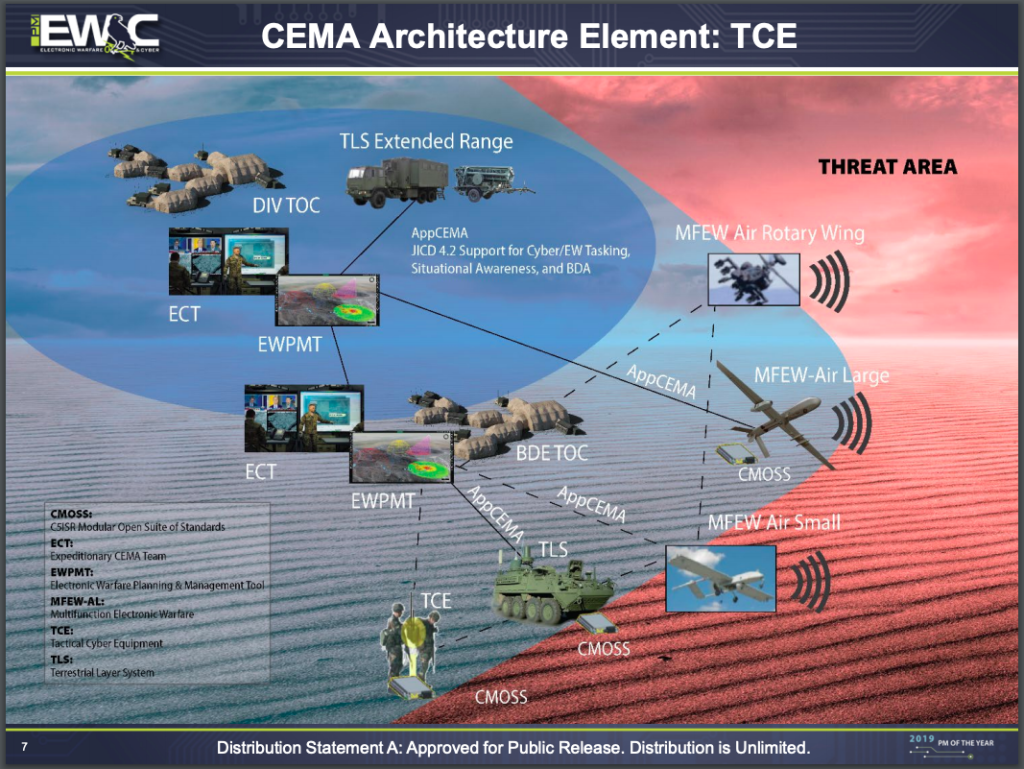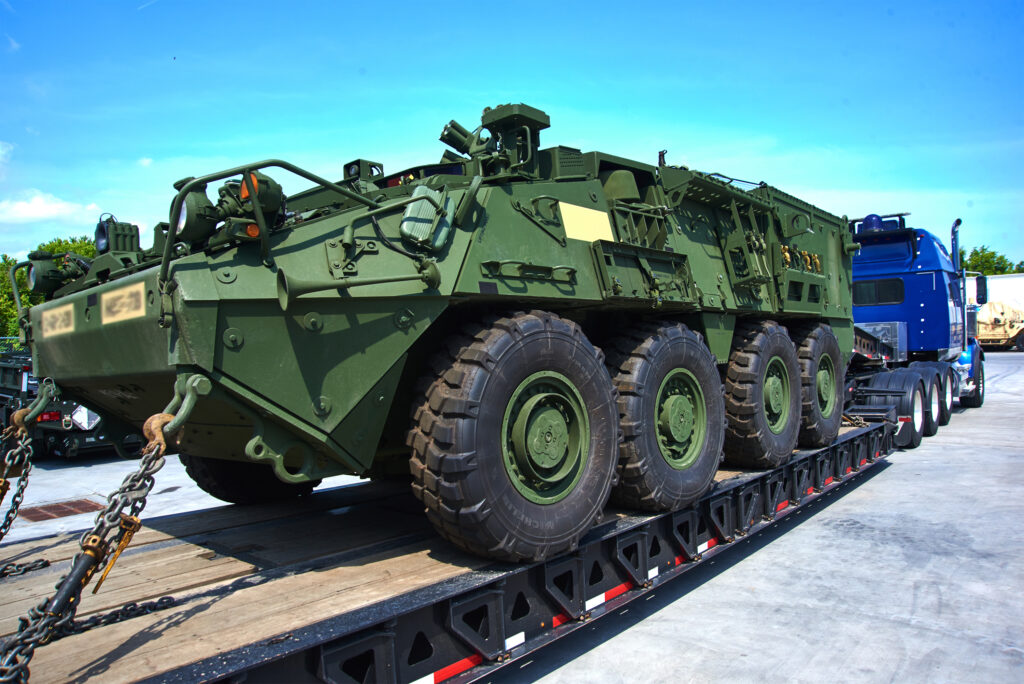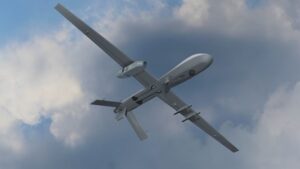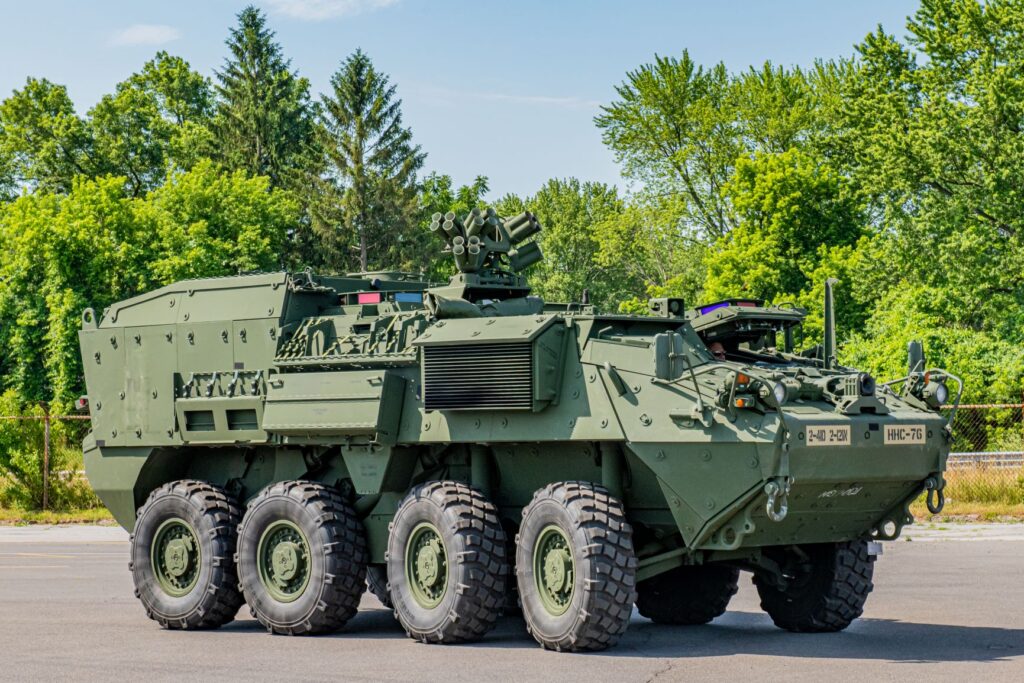By SYDNEY J. FREEDBERG JR.
Each of the Army’s future jammers plugs into a larger electronic warfare network.
 WASHINGTON: After decades of US neglect of electronic warfare – while Russia and China pulled ahead – Army soldiers are just months away from getting their hands on two new and long-awaited long-range jammers.
WASHINGTON: After decades of US neglect of electronic warfare – while Russia and China pulled ahead – Army soldiers are just months away from getting their hands on two new and long-awaited long-range jammers.
Two contractors, Lockheed Martin and Boeing DRT, are now converting 8×8 Stryker armored vehicles into prototypes of the Terrestrial Layer System (TLS). Both company’s prototypes will be given to troops for field tests next year, starting with Operational Demonstration 1 in January. Meanwhile, Lockheed is putting together the first Engineering & Manufacturing Demonstration (EMD) prototype of an EW pod for the Grey Eagle drone, called Multi-Function Electronic Warfare – Air – Large (MFEW), which will be assessed by soldiers in April-June next year.
Both the ground-based TLS and the aerial MFEW are supposed to enter service in fall 2022. But that’s just the start. Each system will evolve into a whole family of smaller and larger variants, all built to common hardware and software standards, all sharing data wirelessly with one another, Army commanders, and artillery units. The objective is a diverse digital arsenal that can detect the enemy’s transmissions, crack their codes, locate their units for precision strikes, and disrupt their networks with jamming and hacking, ideally in ways too subtle for the enemy to even detect the deception.

A Stryker armored ambulance variant arrives at Boeing DRT for conversion into a Terrestrial Layer System prototype (Leonardo DRS photo)
This concept shows potential, when the Army has only a handful of hastily fielded experimental jammers – because even if you can’t jam an enemy transmitter, you can triangulate its location and shoot at it, taking it off the air for good. In a Cyber Quest exercise last year, program manager Col. Kevin Finch told Breaking Defense, the Army plugged a new sensor into its electronic warfare control software, EWPMT, which fed targeting data to the artillery’s control system, AFATDS, which told gunners where to aim.
In the Army’s plan for the tactical cyber/EW force, “these systems are definitely talking, going back to the brigade or to the division or to the corps,” Finch told me. “Once we’re able to get that data to the brigade TOC [Tactical Operations Center], it can be disseminated to whatever system they need to send it to.”
TLS and MFEW will also be able to import data more directly from intelligence agencies, he said, without having to modify data formats as current Army systems do.
Lockheed Martin’s Silent Crow cyber/electronic warfare pod on an Army MQ-1C Grey Eagle drone. Silent Crow is the basis for MFEW-Air-Large (Lockheed illustration)
 The different systems will be united by a common technical standard for electronics, CMOSS; a common data messaging format optimized for cyber/electronic warfare, AppCEMA; and a common software framework, Photon. (Photon is already used on a small number of urgently deployed jammer vehicles called TEWS; the other two are new). While each system will have its own strengths and special techniques, Finch said, the goal is that any Army EW operator can quickly switch from one to another.
The different systems will be united by a common technical standard for electronics, CMOSS; a common data messaging format optimized for cyber/electronic warfare, AppCEMA; and a common software framework, Photon. (Photon is already used on a small number of urgently deployed jammer vehicles called TEWS; the other two are new). While each system will have its own strengths and special techniques, Finch said, the goal is that any Army EW operator can quickly switch from one to another.
That’s a stark contrast to the Army’s current hodgepodge of EW kit. Mostly short-range jammers urgently fielded to defeat radio-controlled IEDs in Iraq and Afghanistan, the current systems were built by different companies with different technical standards, data formats, and user interfaces. In the near term, that makes it difficult to train soldiers on them and to get them to work together; in the long term, it makes it difficult to upgrade them as technology races ahead, since you can’t just plug in the best available new products without extensive modification. The new common standards should simplify all that.
“If we go back and look at systems we’ve designed in the past, I wouldn’t say they’re one-trick ponies, but they’re specifically designed to go after certain things, [and] it was very, very hard to upgrade those systems” to face new threats, Finch told me. With MFEW and TLS, he said, “the big thing that we’re trying to do is make sure that we have systems that we can easily upgrade to pace the threat. That is the critical piece.”
Israel and the United Arab Emirates have announced an historic diplomatic agreement catalyzed by the growing security threat posed by Iran. The United States, concerned about Tehran’s regional and nuclear ambitions, is leading an effort at the UN this week to prevent the Security Council’s arms embargo on Iran from expiring on October 18. If…
Flexibility is key. Old-school electronic warfare relied heavily on raw power. Transmit enough static on a given set of frequencies, and the enemy can’t use its radar or radio. But modern electronics are much more agile, with their operating parameters controlled by software rather than built into hardware, so they can quickly change which frequencies they’re using to avoid the jamming. So instead of just “yelling louder than the other guy,” Finch said, the Army is pursing more sophisticated techniques, combining signals intelligence (SIGINT) with electronic warfare and radio-delivered cyber attacks.

Stryker provided to Lockheed Martin for TLS prototype
The Terrestrial Layer System is moving swiftly, having moved in May to a streamlined procurement process known as Middle Tier Acquisition. Four different vendors submitted “bid samples” – basically the core electronics, without a vehicle – for testing in anechoic chambers. Earlier this year, the Army selected Boeing DRT and Lockheed to build prototypes, giving each company a Stryker to install its electronics on. (The Strykers being used for the prototypes are the ambulance variant, since that’s roomier than the standard troop carrier).
Soldiers will take each company’s prototype vehicle into the field in January for Operational Demonstration One, checking to see how well the technology works in real-world conditions. Their feedback will help the vendors fix any glitches before going into Operational Demonstration Two in April.
But the Army doesn’t plan to operate solo TLS Strykers on the battlefield: It wants to field them in platoons of three, each vehicle sharing data automatically with the others to get a picture of the battlefield that’s much bigger than the sum of its constituent parts. So both companies are building two additional prototypes, which will take the field for platoon-level exercises in June and July. That will be the system’s first Operational Assessment, followed – after any needed fixes and updates — by a second in the fall.
After that, the Army will be able to assess whether TLS is ready to enter production. If it is, the first operational unit will receive the vehicle in fall 2022 – and the Army’s long-neglected electronic warfare force will take a big leap forward.
No comments:
Post a Comment